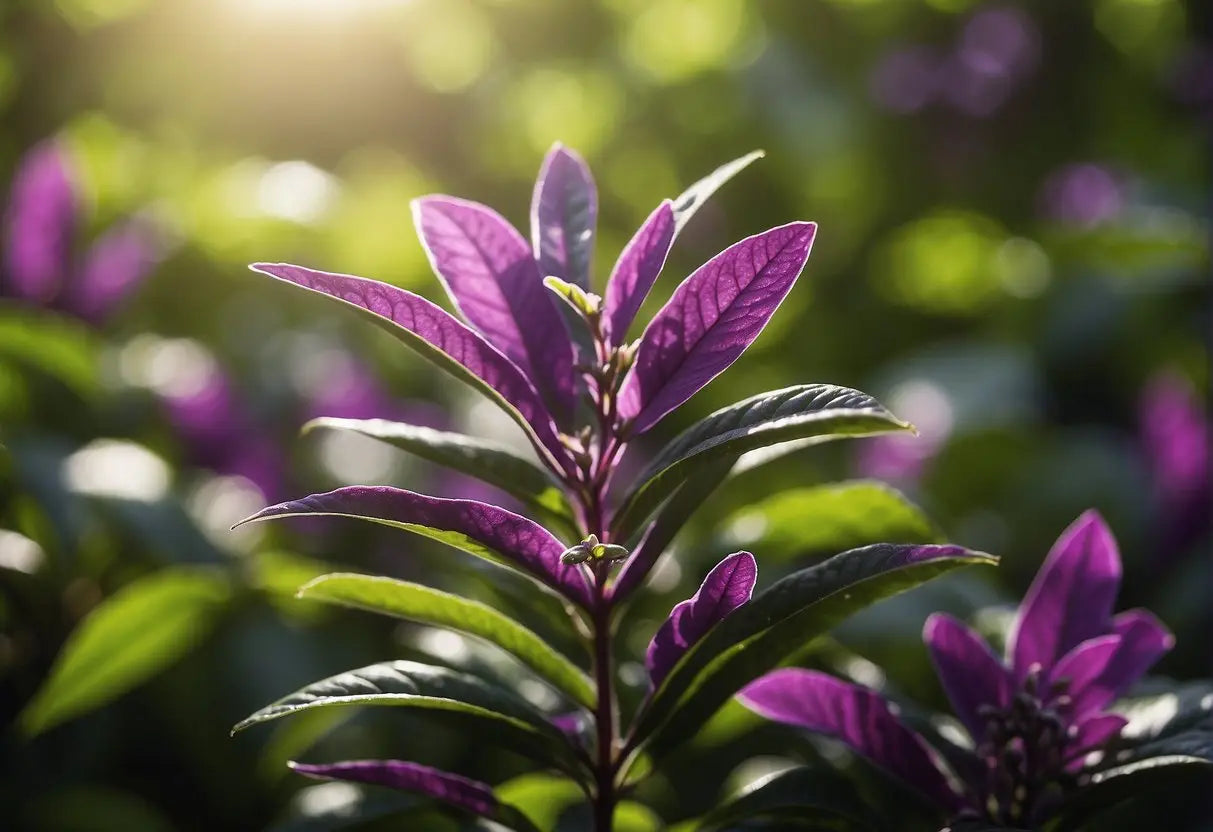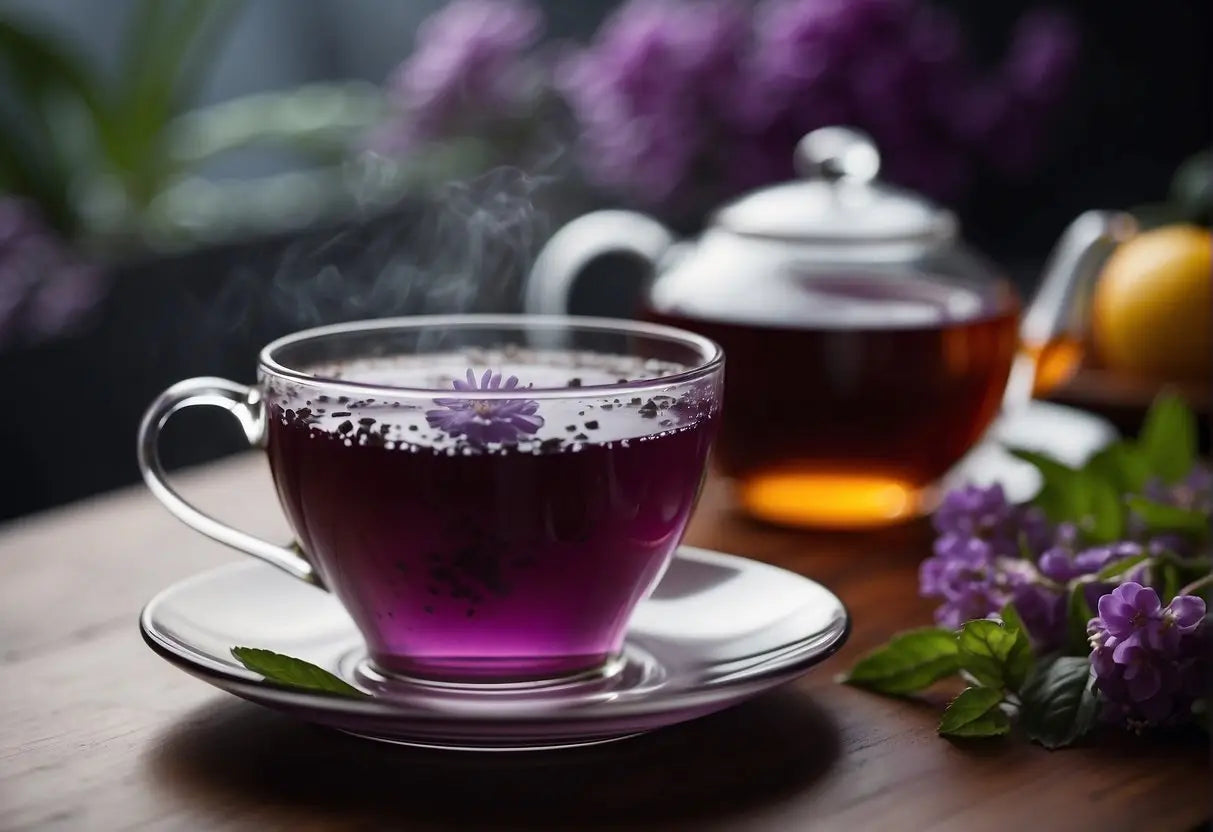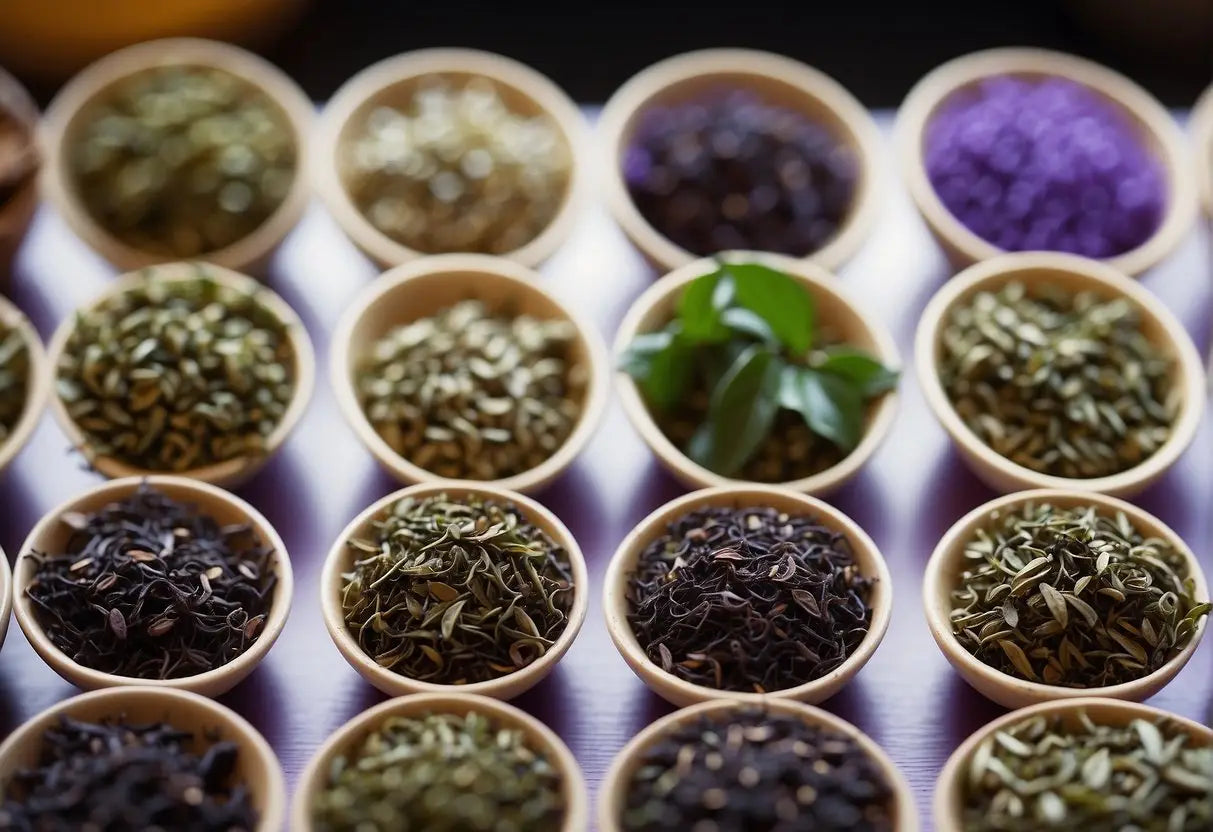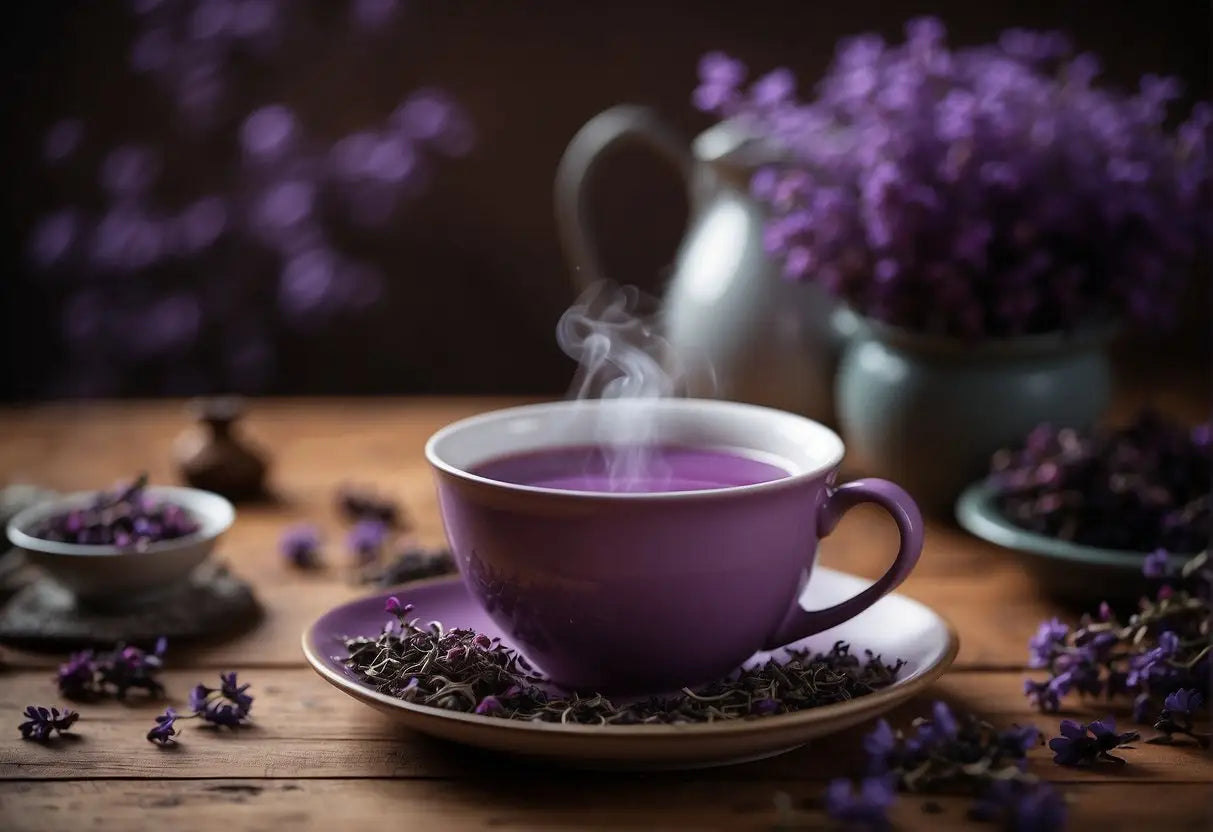What is Purple Tea
Purple tea is a unique variety of tea that originates from the Camellia sinensis plant, which is also the source of traditional black, green, and oolong teas. This vibrant tea gets its name from the purple color of its leaves, which is due to a unique type of pigment known as anthocyanin. Anthocyanin is also found in other plants, such as blueberries and eggplants, and is well-recognized for its potential health benefits.
Grown predominantly in the highlands of Kenya, purple tea is not only distinctive for its color but also for its healthful properties. It's rich in antioxidants, which you may know play a critical role in fighting free radicals and may support overall health.
- Taste Profile: Slightly sweet and woody, with a pleasant, mild flavor.
- Caffeine Level: Similar to green tea, which is generally lower than black tea.
- Brewing Temperature: 75–85°C (167–185°F) is optimal.
The cultivation of purple tea is designed to be sustainable and supports the local economy. Sustainable Practices are key to its production. You can enjoy your cup knowing it contributes to the well-being of the environment and the farmers.
Bestsellers
Your experience with purple tea will not only be a delightful addition to your daily routine but also a step towards a healthier lifestyle. As a distinct and beneficial tea, its growing popularity is a testament to its unique characteristics and potential health advantages.
Origins and History of Purple Tea
Purple tea is a unique variety of tea that originates from Kenya. Developed by the Tea Research Foundation of Kenya, this tea comes from a new cultivar of Camellia sinensis called TRFK 306. In the tea's development, which began in the 1980s, researchers aimed to create a tea that could withstand harsh climates and resist pests.
| Key Periods | Events |
|---|---|
| 1980s | Initial research and development |
| Early 2000s | Commercial cultivation begins |
You'll observe that purple tea leaves have a distinctive color due to anthocyanins, the same antioxidants found in other purple-colored plants like blueberries. These antioxidants are believed to offer health benefits, a fact that has contributed to the tea's growing popularity.
Cultivation primarily takes place in the Nandi Hills and the Mt. Kenya region where the unique climate enhances the tea's properties. Your encounter with purple tea is likely due to an increase in global demand, sparked by its potential health benefits and distinctive taste.
Its production is still small scale compared to black, green, and oolong teas. However, it's gaining recognition for its low caffeine content and high levels of antioxidants. As you explore the world of teas, remember that purple tea's history is relatively young but its roots are deeply entrenched in Kenyan innovation and traditional tea cultivation.
Characteristics of Purple Tea

Purple tea is a unique variant of the Camellia sinensis tea plant. What sets it apart is the Anthocyanin content which gives the leaves a distinct purple hue. Anthocyanins are the same natural compounds found in other purple plants like blueberries and grapes. This type of tea originates largely from Kenya, but can also be found in other tea-producing regions such as China and India.
Your experience with purple tea starts with its appearance. You'll note the leaves range from purple to dark green with a purple blush. When brewed, the infusion offers a light purple to rose tint, a visual cue to its name.
In flavor, purple tea is mild and woodsy with notes that can remind you of ripe plums or fresh foliage. The taste is more subdued compared to the boldness of black tea or the vegetal quality of green tea. It doesn't possess the grassy taste often associated with green teas and contains low levels of caffeine.
From a nutritional standpoint, purple tea is celebrated for its health benefits. Its anthocyanin content implies a high level of antioxidants, and it's suggested to have anti-inflammatory properties. Below is a breakdown of its characteristics:
| Aspect | Detail |
|---|---|
| Appearance | Purple/dark green leaves; light purple brew |
| Flavor | Mild, woodsy, with notes of ripe fruit |
| Caffeine Content | Lower than black and green tea |
| Antioxidant Content | High due to Anthocyanins |
| Origin | Primarily Kenya, also China and India |
Enjoy your journey with purple tea as a beverage that stands out not only for its color but also for its potential health benefits and distinct flavor notes.
Cultivation of Purple Tea
Purple tea is a unique variety of tea, deriving its name from the purple coloration of its leaves, which is due to a high presence of anthocyanins. This tea is not only distinctive in color but also in its cultivation methods and geographic specificity.
Lao Ban Zhang
Geographic Regions
Your interest in purple tea takes you to the highlands of Kenya, specifically the regions around Mount Kenya and the Rift Valley. This area provides the ideal conditions for purple tea plants, with altitudes ranging between 1,500 to 2,500 meters above sea level. The equatorial location of Kenya grants ample sunlight coupled with moderate temperatures, fostering the phenotypic expression that results in the tea's unique pigmentation.
Agricultural Practices
In cultivating purple tea, you will notice a set of practices that are distinct to this variety. The soil is tested for pH balance and is maintained at a level that supports tea plant health. Tea bushes are pruned every couple of years to encourage new growth, and the use of pesticides is minimal to keep the leaves as natural as possible.
Harvesters pick the top two leaves and the bud—the prime part of the plant that contains most nutrients. The precise timing of harvesting is crucial: it must coincide with the peak period of anthocyanin concentration in the leaves, usually just after the rainy season when sunlight is abundant.
The cultivation process of purple tea, while specialized, aligns closely with those of other tea varieties. Its unique attributes are a result of both the terroir and the dedicated methods employed by farmers in these regions.
Health Benefits of Purple Tea
Purple tea offers a unique blend of health benefits due to its distinct anthocyanin content and high levels of polyphenols.
Antioxidant Properties
Your purple tea's vibrant color comes from anthocyanins, potent antioxidants that help combat oxidative stress and may reduce the risk of chronic diseases. Polyphenols, another key component, further reinforce this beverage's defense against free radicals.
Cardiovascular Health
Purple tea supports your heart health by potentially lowering bad cholesterol levels and improving blood vessel function. Studies suggest that regular consumption can lead to a modest reduction in blood pressure, which is crucial for maintaining a healthy cardiovascular system.
Weight Management
Integrating purple tea into your diet may assist in weight management. Its low-calorie content coupled with the ability to enhance fat metabolism gives you an edge in controlling your body weight. Additionally, purple tea has been observed to influence the reduction of abdominal fat.
Brewing Purple Tea

When brewing purple tea, precision in water temperature and steeping time is crucial to extracting the most balanced flavor.
Optimal Water Temperature
To achieve the ideal flavor profile, heat your water to 85°C (185°F). Using water that's too hot can lead to bitterness, while water that's not hot enough may result in a weak infusion.
Steeping Time
For the best taste, steep purple tea for 3 to 5 minutes. A shorter steeping time will produce a lighter, more mellow taste, whereas a longer steeping time can bring out more nuanced flavors. However, exceeding 5 minutes may cause the tea to become overly astringent.
- Note: Adjust the steeping time based on your flavor preference, starting with the recommended range.
Flavor Profile and Aroma of Purple Tea

When you brew purple tea, you can expect an intriguing flavor profile that is different from your typical green or black teas. The unique anthocyanins that give this tea its signature hue are also believed to influence its taste. Purple tea commonly presents a sweet, yet woody undertone with hints of floral notes. Unlike the robustness of black tea or the vegetal quality of green tea, it's often described as mild, with a light body and complexity in taste, usually devoid of astringency.
The aroma of purple tea can vary depending on the specific varietal and processing method. Generally, you'll notice a fresh, clean scent with subtle notes of earthy qualities. Some drinkers describe the aroma as reminiscent of black currants or ripe plums, indicative of the rich presence of anthocyanins. While smelling the tea, you might even detect a slight minty or floral fragrance that contributes to its unique bouquet.
Here's a succinct breakdown of the taste and aroma characteristics:
-
Taste:
- Sweet
- Woody undertones
- Light body
- Floral notes
- Non-astringent
-
Aroma:
- Fresh and clean
- Earthy qualities
- Notes of black currants or ripe plums
- Possible minty or floral fragrance
Enjoying purple tea, you should steep it at lower temperatures compared to other teas to preserve the delicate flavor compounds and to ensure that its distinctive profile is expressed fully in your cup.
Purple Tea Varieties
When looking into purple tea, you'll primarily come across the Camellia sinensis varietals that are rich in anthocyanins, the same pigments that color red, purple, and blue fruits. These teas are often distinguished by their unique color and potential health benefits. Here are the main varieties you might encounter:
-
Kenyan Purple Tea: This tea originates from Kenya and is often referred to as TRFK306/1. It is cultivated in regions with cooler climates and has a lighter taste compared to traditional black teas. Kenyan purple tea leaves have a distinct purple hue and are known for their high anthocyanin content.
-
Assam Purple Tea: Found in the Assam region of India, Assam Purple Tea is a newer varietal with a rich, robust flavor. It is bolder than the Kenyan variety, offering a darker infusion with a deep purple tint.
-
Wild Purple Tea: This variety is not as widely cultivated and can be found in select regions of China and India. The leaves are typically darker and provide a flavor that’s a mix between oolong and black tea, with a slightly woodsy and sweet taste.
You can enjoy these teas in various forms, including:
- Loose-leaf: Allowing full appreciation of the tea's color and intricate flavors.
- Tea bags: For convenient brewing.
Remember to brew purple tea using water that is just below boiling, around 85-90°C (185-194°F), to prevent bitterness and bring out the best taste and color.
Comparison With Other Teas

Purple tea is distinct in its properties and offers unique benefits compared to other tea varieties. You can expect differences in taste, health advantages, and brewing methods.
Green Tea
Compared to green tea, purple tea has a less astringent taste and often a more pleasing, sweet-earthiness profile. In terms of health benefits, it's high in polyphenols like anthocyanins, which are less prevalent in green tea. Green tea is well-known for its catechins, particularly epigallocatechin gallate (EGCG), which are also present in purple tea but with a different antioxidant profile.
- Taste: Less astringent, sweetly earthy
- Polyphenols: High in anthocyanins, contains catechins
Black Tea
Black tea is fully oxidized, which gives it a robust flavor and higher caffeine content than purple tea. In contrast, purple tea undergoes minimal oxidation, preserving higher levels of antioxidants. This means your cup of purple tea can offer a gentle stimulant effect without the stronger buzz associated with black tea.
- Oxidation: Minimal in purple tea, full in black tea
- Caffeine: Less in purple tea, more in black tea
Oolong Tea
Oolong tea is partially oxidized, placing it between green and black teas in terms of flavor and antioxidant levels. Purple tea, however, often has higher levels of anthocyanins due to its unique cultivar. While oolong can range from sweet and floral to rich and roasted, purple tea typically features a lighter, woodsy profile with notes of ripe plums and a purple hue.
- Oxidation: Partial in oolong, minimal in purple tea
- Flavor: Varies in oolong, woodsy and plummy in purple tea
Usage in Culinary and Products

Purple tea, a unique variant from the Camellia sinensis plant, is gaining popularity for its potential health benefits and distinct flavor profile. When brewing, expect a light violet hue and a mild, sweet, floral taste that is quite different from traditional green or black teas.
In the Kitchen:
- Brewing: Steep purple tea leaves in hot water for about 3 to 5 minutes for optimal flavor.
- Flavor Pairing: Complements light pastries and fruit desserts with its subtle sweetness.
- Cold Beverages: Can be served iced for a refreshing drink, often enhanced with lemon or honey.
- Culinary Dye: The purple color can be used as a natural dye for foods like rice or pastries.
Products Containing Purple Tea:
- Tea Bags & Loose Leaf: Marketed for those who appreciate specialty teas.
- Health Drinks: Incorporated into smoothies and health drinks for its antioxidant properties.
- Cosmetics: Utilized in beauty products for its claimed anti-aging benefits.
- Supplements: Available in capsules for those seeking the tea's health benefits without brewing.
When selecting purple tea products, ensure they are sourced from reputable suppliers to guarantee the quality and authenticity of the tea.
Note: Availability and applications may vary by region, reflecting the adaptability of purple tea as a culinary ingredient and commodity in consumer products.
Storage and Preservation of Purple Tea
To ensure the quality and longevity of purple tea, proper storage and preservation techniques are essential. When storing your purple tea, keeping it away from air, light, moisture, and strong odors is crucial. Here's a guideline to help you ensure your purple tea remains fresh and flavorful for as long as possible.
Containers: Use airtight containers to store your purple tea. Ideal materials include tin, opaque glass, or ceramic with a non-transmitting seal to prevent exposure to air and light.
Temperature: Store your tea in a cool, dry place. The ideal temperature range is between 20-25°C (68-77°F). Avoid areas prone to temperature fluctuations, such as above a stove or next to an oven.
Moisture: Ensure your storage area is free from moisture as it can lead to mold growth. Do not store your tea in the refrigerator or freezer, as the condensation can damage the leaves.
Odors: Teas can absorb flavors and odors from their environment. Store your tea separately from spices, coffee, or any strongly scented items.
| Do | Don't |
|---|---|
| Keep tea in airtight containers | Expose tea to air and light |
| Store in a cool, dry place | Store in areas with high humidity |
| Keep away from strong odors | Store near spices or flavored items |
Remember to always handle your tea leaves gently to avoid crushing them and altering the flavor profile. By following these storage and preservation tips, you will help maintain the integrity and distinct character of your purple tea.
Market Availability and Consumer Demand
Your interest in purple tea might lead you to wonder about its availability and popularity. Purple tea is less common than traditional green or black teas but is gradually gaining market presence. Originally cultivated in Kenya, it's now sourced globally, though still in limited quantities.
Key points on market availability:
- Geographic Spread: Primarily found in specialized tea shops and online retailers.
- Distribution Channels: Available through direct import or select resellers.
- Limited Editions: Occasionally featured in seasonal or limited-edition tea collections.
When it comes to consumer demand:
- Health-Conscious Consumers: Higher demand among those seeking antioxidant-rich alternatives to conventional teas.
- Novelty Seekers: Attracts buyers looking for unique and exotic tea varieties.
- Price Point: Generally priced higher than regular teas, which may affect demand.
Purchase options:
- Online Platforms: Widespread availability across e-commerce websites.
- Subscription Services: Inclusion in niche tea subscription boxes.
- Specialty Stores: Physical availability in tea specialty shops, particularly in urban centers.
Awareness and popularity are rising as tea enthusiasts and health-conscious consumers become more informed about purple tea's unique properties and benefits. Although still a niche market, growth is anticipated as its profile expands.
Frequently Asked Questions

Purple tea offers unique advantages and experiences, and you may have questions about its health benefits, processing, availability, effective usage, flavor profile, and preparation.
What are the health benefits associated with purple tea?
Purple tea contains high levels of anthocyanins, which are antioxidants that may help protect your cells from damage and could reduce inflammation. This tea also has lower caffeine content compared to black and green teas, which makes it a milder option for those sensitive to stimulants.
How is purple tea processed and what gives it its unique color?
The unique color of purple tea comes from anthocyanins, the same pigments that give blueberries and red cabbage their characteristic hues. Purple tea is processed similarly to green tea, but the oxidation is halted, which preserves its distinct color and beneficial compounds.
Where can one purchase high-quality purple tea?
High-quality purple tea can be found in specialty tea shops, online retailers, and sometimes in health food stores. When purchasing, look for suppliers who specialize in or are knowledgeable about purple tea to ensure authenticity and quality.
Can purple tea aid in weight loss and how is it most effectively used for this purpose?
Some studies suggest that the polyphenols and lower caffeine content in purple tea can help boost metabolism without overstimulating the heart, making it a supportive beverage for weight loss. Drinking it regularly, without added sugars or high-calorie additives, can be an effective way to incorporate it into a weight loss regimen.
What distinct flavor profile can one expect when drinking purple tea?
Purple tea offers a unique flavor profile that is typically sweet and woodsy with a hint of grassiness. It is less astringent than black tea and offers floral notes that some find reminiscent of oolong tea.
How should one best prepare purple tea to maximize its taste and benefits?
To maximize the taste and benefits of purple tea, brew it with water at around 70-85°C (158-185°F) for about 3 to 5 minutes. Using filtered water can improve the taste, and it's recommended to start with shorter brewing times and adjust according to your taste preferences.
← Older post Newer post →











